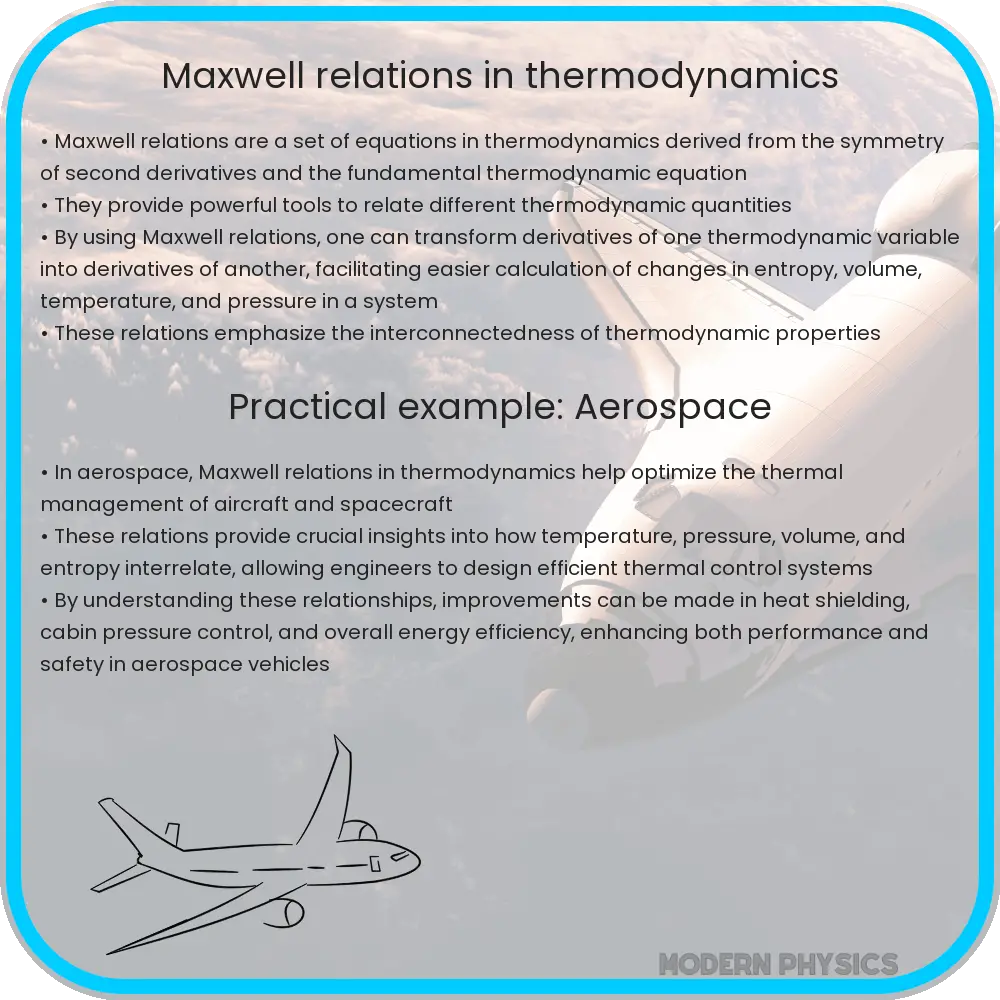Explore Maxwell Relations in thermodynamics, their derivation, applications, and modern advances in this comprehensive guide.

Understanding Maxwell Relations in Thermodynamics
Maxwell Relations are fundamental equations in thermodynamics, derived from the second law of thermodynamics and the definition of the thermodynamic potentials. These relations are pivotal in simplifying the calculations of various thermodynamic processes and understanding the interrelations between different thermodynamic properties.
Key Concepts Behind Maxwell Relations
Maxwell Relations stem from the thermodynamic potentials: internal energy (U), enthalpy (H), Helmholtz free energy (A), and Gibbs free energy (G). Each potential is a function of different thermodynamic variables like temperature (T), entropy (S), pressure (P), and volume (V).
The relations are derived using the properties of exact differentials in mathematics and the fundamental thermodynamic equations. For instance, the differential forms of U, H, A, and G allow for the derivation of four Maxwell Relations. These relations connect the partial derivatives of T, S, P, and V in various combinations.
Applications of Maxwell Relations
Maxwell Relations have wide applications in various fields of science and engineering. They are particularly useful in predicting the response of a system to changes in external conditions without the need for direct experimental measurements. This capability is vital in chemical engineering, materials science, and physics.
- Thermal Expansion and Compressibility: These relations help in calculating the coefficients of thermal expansion and isothermal compressibility, crucial in understanding material behavior under temperature and pressure changes.
- Heat Capacities: Maxwell Relations aid in relating the heat capacities at constant pressure (Cp) and constant volume (Cv).
- Phase Transitions: They are instrumental in analyzing phase transitions in materials, providing insights into entropy and enthalpy changes during such processes.
Overall, Maxwell Relations serve as a bridge between various thermodynamic quantities, allowing for a deeper and more integrated understanding of thermodynamic systems. Their derivation and application are key elements in advanced thermodynamics courses and research.
Detailed Analysis of Maxwell Relations
Delving deeper into the Maxwell Relations, each relation equates the mixed second partial derivatives of thermodynamic potentials. For example, one of the Maxwell Relations derived from the Gibbs free energy states that the partial derivative of entropy with respect to pressure at constant temperature is equal to the negative of the partial derivative of volume with respect to temperature at constant pressure. Mathematically, it is expressed as:
\[ \left( \frac{\partial S}{\partial P} \right)_T = -\left( \frac{\partial V}{\partial T} \right)_P \]
This equation simplifies the process of determining how a system’s entropy changes with pressure or how its volume changes with temperature.
Challenges and Limitations
While Maxwell Relations are incredibly useful, they also come with certain limitations. Their application requires the system under study to be in thermodynamic equilibrium. Additionally, these relations assume the absence of phase changes or chemical reactions during the process, limiting their applicability in dynamic systems.
Modern Applications and Advances
In recent years, the scope of Maxwell Relations has expanded, finding applications in fields like renewable energy, where they assist in optimizing thermal systems for efficient energy conversion. Advanced research in thermodynamics often involves the use of Maxwell Relations in conjunction with computational methods to model complex systems, such as atmospheric phenomena or advanced materials.
Conclusion
Maxwell Relations represent a cornerstone of thermodynamic theory, bridging the gap between theoretical understanding and practical application. These relations exemplify the power of mathematical abstraction in physical sciences, providing elegant solutions to complex problems. Whether in academic research, engineering design, or material science, Maxwell Relations continue to play a crucial role in advancing our understanding and manipulation of the world around us. The ongoing exploration and application of these principles symbolize the dynamic and ever-evolving nature of scientific inquiry, highlighting the beauty and complexity of thermodynamics.
